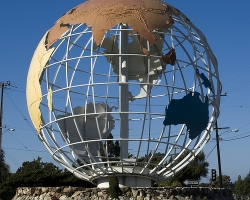More than 500 residents packed a local community clubhouse recently to hear experts describe the likelihood and consequences of a major earthquake striking our region and how to best prepare for it.
The San Andreas Fault and parts of the San Jacinto and Lake Elsinore faults are what geologists call “locked and loaded,” said Dr. David Bowman, chair of the Geological Sciences Department at Cal-State University, Fullerton.
That means they are capable of producing a very large earthquake and are ready to do it at any moment, he said.
“When the San Andreas goes it will be a lot bigger (quake) than a 6.7,” the size of the 1994 Northridge earthquake, Bowman said. It will produce a 7.5 “maybe up to an 8 if it goes the entire length of the fault.”
The 2007 Uniform California Earthquake Rupture Forecast, the most comprehensive analysis of earthquake probabilities ever undertaken, determined that there is a 99.7 percent likelihood California will be struck by one or more magnitude 6.7 quakes sometime in the next 30 years.
The fault with the highest probability of such quakes—59 percent—is the southern San Andreas. The region also stands a 37 percent chance of one or more quakes of magnitude 7.5 or greater striking within the same time period, the study said.
”Northridge lasted between seven and 15 seconds, depending on where you were, Bowman said. “I lived in Playa del Rey at the time and I can tell you it lasted at least five years. But in reality it was only about 10 seconds where I was. This one will go a lot longer, which is one of the reasons we are so concerned.”
A magnitude 7.8 quake could cause $213 billion in damage and injure more than 53 million people in the Los Angeles region, according to a United States Geological Survey scenario. The Leisure World event, where Bowman spoke, aimed at helping residents be aware of and prepare for such a disaster.
While Leisure World is “pretty safe” from a tsunami, Bowman said, one serious concern for the area in a major quake is liquefaction.
“You are smack in the middle of a liquefaction hazard zone,” as outlined in the official state liquefaction hazard maps, he said.
Liquefaction occurs when an earthquake’s strong shaking meets a high water table—temporarily turning the ground to quicksand. The result, among other things, is that buildings can tilt, Bowman said.
With liquefaction, buildings are more in jeopardy than people.
An entertaining speaker, Bowman used his son’s toy fire station and beach sand to demonstrate the effects of liquefaction on buildings. He also joked about his budget as an employee of the State of California, bringing out a homemade model to demonstrate the effects of different kinds of quakes on buildings.
Bowman was joined on stage by Col. Philip Butch of the Domestic All Hazards Response Team and Orange County Fire Authority Division Chief Ed Fleming.
Butch and Fleming assured the crowd that whenever a disaster strikes, they will eventually bring help, but both emphasized the importance of preparedness.
“It’s very easy to become a victim and there is a finite amount of resources out there, said Butch, of the Joint Force Training Base in Los Alamitos. “Everyone will be competing for the same resources, whether it be rescue, fire, police or the military. So you have to … prepare yourselves, your neighbors, your community. Your block captains will be extremely important until help does arrive.”
Butch complimented the nearly 9,000-resident senior community for its pro-active effort to get everyone prepared to take care of themselves in the early days after a major disaster.
“Remain vigilant, remain resilient, remain prepared and take care of your fellow man,” he said. “I’m advocating the whole of community approach.”
Chief Fleming delivered a pointed message on preparedness focusing on what the local community could expect in a major disaster.
“At the fire level we (will be) focused on major emergencies,” Fleming said.
If a smaller building collapses that will likely have to be handled by your Community Emergency Response Team, he said. “They are going to have to handle that on their own.”
“The smaller fires, who gets that? You do. Your CERT teams.”
Fleming urged his listeners to get involved with various response efforts through fire departments, CERT, the Medical Reserve Corps and the Planning for Emergency Preparedness Foundation, which sponsored the event.
Butch and Fleming assured the audience that professional emergency responders will come to aid them in time. But they urged everyone to be ready to care for themselves for a minimum of three to 14 days.
Joining the speakers for the evening’s question and answer session were members of Col. Butch’s team—Major Aaron Schilleci and Major Joseph Adams – plus Community Emergency Response Team leader Todd DeVoe of the City of Seal Beach and Eloy Gomez, Leisure World’s Safety and Emergency Coordinator.
Besides hearing the speakers, resident volunteers attending the “2nd Annual All-Leisure World Building Captains, Emergency Captains and Other Volunteers Event” swarmed a plethora of booths. Presenters offered information on everything from how to care for pets in a disaster to how to be part of preparedness opportunities such as CERT and PEP.
Hal Kirman, the event’s master of ceremonies, headed up the team of more than two-dozen PEP volunteers who made the event happen.
“We’re very grateful to our excellent speakers and look forward to working with all of them again,” said Scott McIntyre, PEP vice president. “And we want to say a special thank you to our entertainers for the evening—Ben Berg, Mr. Hank, Margie St. Claire and Lee Kelley. “But most of all, we want to give an especially warm shout out to all the resident volunteers who came, listened, learned and will continue to spread the preparedness message to our whole community.”
Ann Pepper is president of Leisure World’s Planning for Emergency Preparedness Foundation.




